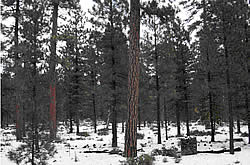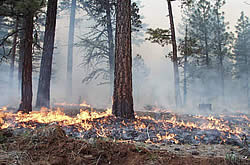
National Fire Plan Success Story
Hackamore Ecosystem Restoration and Enhancement Project
Devil's Garden Ranger District, Modoc National Forest
January 7, 2008

A thinned area in the Hackamore project area.

Prescribed burning in the Hackamore project area.
The Hackamore Ecosystem Restoration Project, located on the Modoc National Forest in the far northeastern corner of California is part of the Upper Pit River Restoration Project, one of twelve-demonstration projects nationwide featuring watershed restoration.
The Hackamore Project was the result of a two year planning effort bringing together Federal land managers, research scientists, local government, environmental groups, the Klamath and Pit River Tribes, local timber industry representatives, state agencies, and interested individuals. The project was approved for implementation in March of 2000.
The objective was to design a series of projects to provide for ecosystem restoration across a 158,000-acre landscape in the Hackamore area on the Devil’s Garden Ranger District adjacent to the communities of Canby and Alturas, California. The purpose and need on a landscape level were:
- Reduce potential for high intensity fire to protect wildlife habitat and capital investments.
- Develop sustainable and diverse forest stands while maintaining and developing late seral old growth stands.
- Enhance key habitat for mule deer, Goshawk, and bald eagle.
- Improve wetland and waterfowl habitat.
- Eliminate 42 miles of redundant roads.
The area is comprised primarily of eastside pine forests, interspersed with sagebrush and juniper woodlands. The understory is characterized by desirable species of shrubs, forbs, and grasses. These landscapes provide key winter habitat for mule deer and nesting habitat for goshawk. The watersheds protected by these forested lands drain into the Klamath River system on the north and the Pit River and Sacramento River system on the south.
Goals of the project are to thin forest stands and re-introduce fire on a broad scale to reduce the potential for high intensity, stand replacing fire, to create more sustainable and diverse forest conditions, and to enhance deer, elk, goshawk, eagle, and waterfowl habitat.
To date the District has completed numerous projects including commercial and biomass thinning followed by prescribed fire, wildlife habitat infrastructure improvement (tanks, islands, etc.), re-forestation, bitterbrush planting, mowing and masticating.
Thinning of over-dense forest stands has provided hundreds of thousands of tons of biomass to local markets for power generation while reducing fuel ladders and improving forest health.
In addition to routine post treatment monitoring, the District has partnered with Forest Service research ecologists and California Dept of Fish and Game to study the effects of fuels treatments on bitterbrush, a key forage component on mule deer winter range. This research is ongoing and has yielded valuable information that has been adaptively incorporated into projects as they are implemented. The project constantly evolves based on new science, trial and error, and new opportunities for improvement.
District Resource staff partner with California Department of Fish and Game, Rocky Mountain Elk Foundation, California Mule Deer Association, CALFIRE and Bureau of Land management and others leveraging ideas, staffing and funding to accomplish work.
When complete, the Hackamore Project will represent a landscape scale undertaking that embraces interdisciplinary and adaptive management, strategic planning, and effective land management resulting in healthy forest conditions that resist stand/habitat replacing wildfire and support a diverse population of wildlife and vegetative species.
The Hackamore project was initiated in 2000. To date, specific to fuels related treatments, we have accomplished approximately:
- 8000 acres of commercial thinning
- 10,000 acres of biomass mechanical thinning
- 8000 acres of underburning
- 3500 acres of understory shrub mowing
Contact:
David McMaster, 530-233-8813
Anne Mileck, 530-233-8803
Jon Stansfield , 530-279-8332